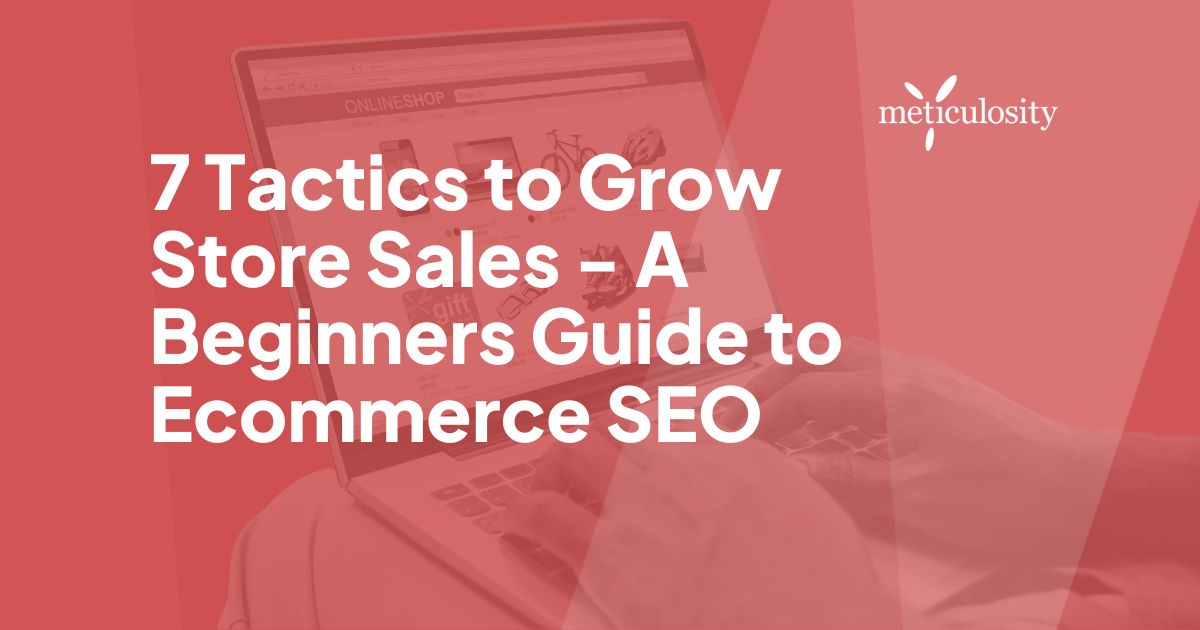It’s common for online merchants to think listing all their products on their ecommerce website or Amazon store is enough to get found in search and drive meaningful traffic.
Unfortunately, that's far from reality without leveraging Search Engine Optimization (SEO), especially with an ecommerce SEO focus. We'll dive into that, but first, a history lesson. Get your website ranking in search. Ultimate Guide to SEO - Download Now >
What is Ecommerce SEO?
Ecommerce SEO is the practice of improving your online store's visibility in search engine results. The primary goal is to rank as high as possible for the products you sell, increase new visitor traffic, and generate more revenue.
/Imported_Blog_Media/ecommerce-seo-1.jpg?width=1200&height=685&name=ecommerce-seo-1.jpg)
Can your Ecommerce Store Guarantee Sales?
Gone are the 'build it, and they will come' days when you could create an online store, submit your site to the search engines, sit back, and watch the visitors (and subsequent sales) roll in.
Nowadays, the competition is just too intense across the internet (and Google search) to find any measure of success without putting effort into your search visibility. Simply put, you need to be visible in search engine results pages (SERP) for potential customers to find you.
How to Use Ecommerce SEO to Rank in Search Results
So, the best way to get discovered by new consumers is to show up consistently in the SERP by using great SEO tactics. The startups and side hustles that turn into multi-million dollar companies don't do it by sheer luck alone. They learn SEO so their ecommerce store can rank on the first page of Google and get in front of a potential customer looking for their product.
While the world of SEO and ecommerce is always changing, a few steadfast rules will always generate concrete results. Luckily, even just a little SEO knowledge can go a long way towards improving your bottom line. If you're looking to improve your rankings and page views, read on for our Guide to SEO.
1. Optimize your Store for Search Engines
You could be selling the most innovative product, but if it's not listed on the first page of Google when consumers search, you may as well be invisible. Your ranking in the search engines can always be improved, but first, you should understand how search engines "interpret" your website content.
How a Search Engine Works for Ecommerce
Search engines use bots that crawl the internet and discover new content like websites, images, or articles through following links. As a crawler follows each internal and external link, it will index (categorize) everything it finds to be a relevant and credible resource.
Then, when a person performs a search, Google will comb through its database of indexed content to display the most relevant listings for the search query. Unfortunately, if your store or product listings aren't in the search engine's index, you won't be visible in the listings - even on a brand search.
To see what's indexed on your ecommerce site, head to Google and type "site:yourdomain.com" into the search bar. You'll get a list of everything indexed on your site and how your listing reads to search visitors. If you find there aren't many product listings or incorrect listings, Google may be having trouble discovering your content or trouble crawling your product pages.
Getting your Store Indexed
Sign up for a Google Search Console account. Within this ecosystem, you can submit your sitemap to Google so it can crawl your site and begin indexing pages. The sitemap.xml file is like a roadmap that Google uses to discover your pages, posts, and products.
NOTE: The sitemap shouldn't replace a good internal link structure and should act as a supplemental directive for the crawler.
However, the sitemap is still helpful if your store is new, has few internal links, or has a small backlink profile. The Google Search Console account is also useful in monitoring (and fixing) all of your indexed content that Google reports issues with.
2. Create Compelling Content
There's a saying we're all sick of hearing - that 'content is king.' But if you think the content doesn't apply to your ecommerce business because you sell products and don't run a traditional site or blog, you'd be wrong.
No matter what your business hopes to accomplish on the web- selling products, marketing, or bringing in new clients- there should always be content positioned to help consumers.
Don't Sell Products, Instead, Solve Problems with Your Products
Your content might be a mix of text, product images, product videos, specifications, FAQs, and fact sheets, but ultimately, it should answer all of your potential customers' questions about your products.
Oftentimes, the listings that stand out are those that are as specific as possible. Explain what the product is, how it works, how many come in a package, its size, purpose, etc. In addition, tell the visitor what your product doesn't do. Most importantly, you must show how your product will solve their challenge or help their life.
On the surface, it may seem counterintuitive, but your duty is to your customer, not the product, and we only want best-fit customers.
Create a Buyer Persona for Your Product Users
Try to imagine your customer's needs and desires for your product, and then answer all of those questions preemptively.
Creating a buyer persona can help identify the unique needs of your buyers. Not only will you gain more consumer trust with the transparent approach, but you'll be able to provide more helpful and useful content. Plus, Google will respect you more and promote your content over others when you put the user over your product(s).
Rich Media for the Win
Marketers know that product videos and well-taken photos are the best ways to get buyers to respond to their merchandise and get them in the buying mood. Besides the visual benefit, high-quality media also has the added benefit of improving search signals and helping you rank higher in the SERP.
High-Quality Images, But with Little or No Product Description
E-commerce sites that sell clothing, shoes, and other fashion products like to keep their pages clean. They often post high-quality editorial photos to show their products at their best. They also keep the text to a minimum to achieve a fresh, clean look for their website. While impressive product photos are important to increase user engagement, these aren’t much of a help SEO-wise.
Search engines like Google are highly literate but can’t read images—they can only recognize and read texts. Whenever a user inputs a set of keywords in a Google search box, Google will match the user with websites containing those keywords. So, if your e-commerce site only contains images (with little or no product description), then you miss the chance of getting search engine users to view your website and check out your items. That defeats the purpose of having an online shop in the first place.
So… How Much Text Should Your Web Pages Have?
The amount of text a page should have is always up for debate. Google’s guidelines, for instance, aren’t clear about how much on-page text is enough. It has become a good practice to write long-form content to boost a site’s SEO visibility. It's also imperative that your content is unique, so refrain from copying product descriptions from the manufacturer’s website or other seller’s shops.
We have found that less than 300 words per product page can be considered thin content, so we now use 300 - 600 words.
Of course, the amount and uniqueness of your page content are not the only things that search engines look for when crawling your web page. Your website's speed, mobile responsiveness, and backlinks also matter to search engines.
But, by simply ensuring your e-commerce site has great aesthetics and quality content, you’re a huge step closer to making your website visible on search engines.
Add Supplemental Content to your Store
If your products are already well-listed and detailed, and you're not seeing great results, it may be time to think about implementing an additional content stream via a blog YouTube channel, or both.
Although it's not for everyone, investing in a blog and/or making informational videos can translate to massive untapped traffic and revenue. We use these tactics all the time to gain a huge SEO advantage in search to outrank competitors.
Demonstrate Product Expertise
It's difficult for Google to decide which products to promote in search when there are so many that are similar. So, the real goal is not specifically to sell products but to become an authoritative source on your product topic or industry. Remember - it's easier and safer to buy from the authority.
Even if you're not a great writer or videographer, you have expertise in your industry that would probably benefit potential consumers looking to make a buying decision.
Nowadays, people aren't looking for 5-star writing; they're looking for useful and helpful knowledge and want to learn from those who share their expertise.
You must write informative posts or create videos if you want great rankings. Your content should cover a consumer topic, need, or challenge in depth, helping a user make a more informed buying decision - even if not your product.
3. Ecommerce Keyword Research
So you've submitted your site index to Google, and your pages are starting to get indexed - hopefully. Fantastic. But why are you still not seeing results? Let's take a look at keywords and how they drive the search rankings.
Years ago, if someone searched for "books," the search engines would find the most suitable pages that mentioned the word "books" frequently. So marketers often use a black hat SEO technique called 'keyword stuffing' to rank their pages highly. It worked for a time. But, this led to horrible customer experiences and ultimately prompted Google to change its algorithms.
Now, you must use keywords in your content in more creative ways than ever before. You'll want to steer clear of big, broad keywords that have entirely too much competition (think "cars" or "planners" or "soccer balls", for example.)
There are so many big players in those categories that it would take a significant amount of paid advertising to rank anywhere near the top of the SERPs (short for search engine result pages.) Instead, you'll want to rank highly for specific keywords that are less searched for but still have the potential to be profitable.
So, instead of using "planner" as your main keyword, try ranking for "fitness planner for busy moms" or "Beachbody coach success planner." The key to success with this tactic is doing plenty of keyword research before picking specific longtail keywords.
Keyword Analysis
You don't even need to pay for anything fancy to get these metrics, either. You can use Google's Keyword Planner for free to find the terms that are most often searched for in your particular industry. Play around on the tool and list all the ways people could search for your products.
Remember to use varying word combinations and keyword lengths. Then, check those terms by searching for them on Google to find any credible gaps in the results. Those are the keywords you'll want to focus on. With Google stating that more than 70% of its searches are long-tail keyword searches, there are plenty of ways that you can rank highly using this method.
4. Create a Great User Experience
There have been many updates to search engine algorithms, with many targeted at reducing spam, shady tactics, and nefarious internet scammers. The end goal has always been to provide a great user experience for internet searchers, which should also be your end goal.
User-friendly Store Organization
If your site is well-organized, easy to read, and loads quickly, you're golden, and Google will probably favor your site in the rankings. Understandably so, most search engines will not feature sites that have dreadfully slow loading speeds or too many ads all over the page, as that usually turns visitors away.
Have a Fast Loading Site
Internet searchers tend to be impatient. They want your site to be lightning-fast and get to what they're looking for in the quickest way possible. Not to mention that page speed has been a ranking factor for Google for over a year now, and it'll benefit your site experience to test your speeds.
To get your site to load with that lightning speed, you'll want to optimize it in a few ways: compress all of your high-quality images, streamline all of your code, and make sure you have a dedicated server for your site if you find that sharing is costing your site in speed. And while you're testing your speed, make sure your site is mobile-friendly.
Considering that over half of internet searches are now done on mobile devices, Google also tends to penalize sites that are not mobile-responsive.
5. Create a Linking Strategy
The way Google discovers new and relevant content is by following links. So, the best way to help Google understand your content is to create a linking strategy.
Link Building
Backlinks are still a great authority signal and a sign of trust to Google. So, you want to try and sprinkle them everywhere. There are two kinds of links, internal and external, and they both provide search engines with valuable information about your site.
Internal Linking
Your site should have plenty of internal links, which are links that stay within your site (such as links back to your homepage or other relevant products.) These internal links keep your pages organized and also help Google crawl your site and index what it finds more efficiently. A great way to use them is by linking two compatible products or services that customers may be interested in by including a link to the other product on each page.
Many bloggers will embed links for previous blog posts for the reader's further reference. This helps both the reader and the website by providing more information and helping the site get ranked higher.
External Linking
External links are created when other websites link back to your products or posts (this is where creating killer content comes into play.) These links are especially useful because they help create a source of authority for search engines and help you grow your page views.
NOTE: The more authoritative the source of the link (New York Times or National Geographic, for example), the more weight it carries for your site's credibility.
6. On-page SEO Tactics
Your website is like your home. You wouldn't invite visitors over with a mess everywhere, and the same goes for inviting customers into your unorganized store.
Redirect any broken links, double-check the readability (font size, color, background, etc.), and ensure that your categories follow a logical sequence; the recommendation for eCommerce SEO success is that your site is no more than 3 categories deep so you don't lose customers in the depths of subcategory hell.
Use On-page SEO Best Practices
You should structure your site so that the most important information is at the top, with everything else being neatly organized underneath. Your titles, headings & descriptions should all be well-written and appropriate for each specific product. Don't miss out on the opportunity to entice customers and gain page rankings with appropriate tags, URLs, and descriptions.
Rename your page URLs so they are keyword-specific (like www.dogworld.com/housebreak-older-dog-spray) and don't contain a long string of random letters and numbers. This will help customers understand what they're clicking on and will help get your page indexed properly.
Using well-structured meta tags like title tags and meta descriptions will also get your site listed higher in the SERPs. You could even edge out the competition if you are able to capture a customer's attention in less than 200 words with a killer meta description.
7. Security and Schema
The internet and search engines like Google are constantly evolving to improve security and user experience.
Secure your Site
A few years ago, Google decided to favor sites whose hosting platforms are secured with a valid SSL certificate. If HTTPS does not secure your site, Google may devalue the content and give it lower rankings.
/Imported_Blog_Media/https-not-secure-750x179-Jun-28-2021-10-47-02-81-PM.png?width=750&name=https-not-secure-750x179-Jun-28-2021-10-47-02-81-PM.png)
In addition, Google will go an extra step to warn visitors that your store is " Not secure." It's a quick fix to get encryption on your site and ease your customers' minds.
Rank for a Featured Snippet with Schema
Schematic markup is another little thing that could gain you major points in page-rank. Schema is a way of labeling your content so search engines better understand what it is.
In fact, optimizing online shops for SEO purposes is more challenging than it is for a magazine site or a simple five-page company website. After all, with many product pages containing mostly images, e-commerce websites often find it hard to tell search engines what their site is about.
8. Ecommerce Tracking for Google Analytics
Google Analytics is a powerful tool for visualizing ecommerce store activities. You can make actionable improvements to boost store sales and website traffic with the right data metrics.
Here are a few benefits of tracking ecommerce sales in Google Analytics:
- Sales & revenue performance tracking.
- See key metrics (KPIs) critical to business operation:
- conversion rate
- average order value
- value per session
- Make informed decisions based on real data
- Generate more sales and revenue







